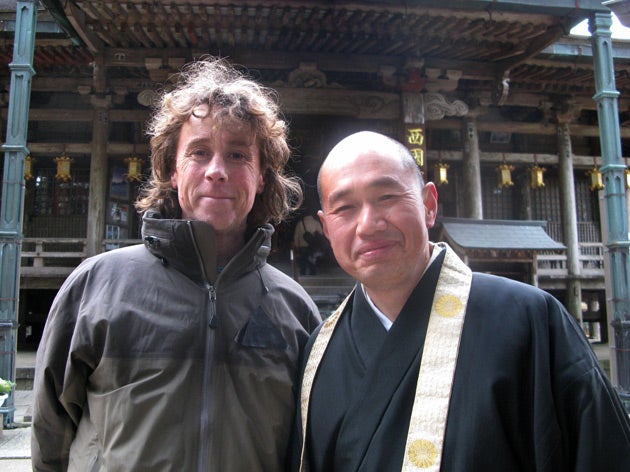The Weekend's Television: Around the World in 80 faiths, Fri, BBC2<br> Prog Rock Britannia – an observation in three movements, Fri, BBC4</br><br>A history of Scotland, Sat, BBC2</br><br>The antiques rogue show, Sun, BBC2</br>
Cult viewing at last

I hope, of course, that we have not already seen the weirdest religion that will ever be featured in Around the World in 80 Faiths.
But it's hard to believe that again in this eight-part series, the far-flung efforts of the Rev Peter Owen Jones, an Anglican vicar from Sussex, will uncover a set-up quite as strange as the John Frum cult. John Frum, it appears, was founded as a challenge to the Christianity that had been assaulting the island of Tanna, in the south Pacific, ever since Captain Cook first turned up there in 1774. The first missionaries had been eaten. But this didn't deter others, and by 1969, when cannibalism finally ended on the island, conversions were so widespread that a determined rearguard action had gathered pace.
A distinct cult first emerged in the 1930s, apparently, with a promise from somewhere that if the islanders would only return to the spiritual traditions of Kastom, then they would be provided for. But the cult didn't get its name or its symbol until the Second World War brought a US air base, and it was decided that Kastom had delivered these free-spending men. They would introduce themselves as "John from...", which became John Frum, and they loved the Stars and Stripes, so the US flag is the cult's most revered religious symbol. Mainly, the cult exists to campaign against the imported religion, untroubled by the Christian identity of the US, but deeply resentful of religious colonisation. In the modest travels the Rev Owen Jones has so far made, in Australasia, it was the odd clashes and weird accommodations between indigenous and imported religions that gave the show its fascination, and its intellectual bite. This might even turn out to be the most interesting religious series the Beeb has ever managed to broadcast.
There were further hints of spiritual ecstasy in Prog Rock Britannia – an Observation in Three Movements, an earnest documentary that attempted to pay tribute to the music that time and embarrassed grown-up men forgot. They were all there, all the boys from grammar schools who brought their Guildhall training to the electric guitar, all the lads from Oxbridge who cringed at three-minute pop lyrics, and flicked instead through Tacticus and Tolkein for inspiration. Their problem, they gradually acknowledged, was that they weren't really interested in audiences or entertainment, but instead were living in a dream, trying to create a value system for the early 1970s that "now seems like an old-time religion". By the time punk happened, they admitted, the prog rockers were entirely divorced from the "shortages, strikes and social disillusionments" that were apparent to everybody else. You had to admire their total commitment to "the delights of the diminished chord". Theirs was a kind of utopia, unless you were trapped in the audience.
And Scotland, of course, is a kind of utopia too, when you're at the top of a mountain on a clear day, and there aren't any other people cluttering the place up. A History of Scotland had ambitions to do for Scots what Alex Haley's Roots did for African-Americans, but has already been shown in Scotland and criticised balefully for being too Anglocentric. That wasn't the case in episode one, which was suitably dominated by Picts, Gaels, Romans and Vikings, just as we were always told at school. Perhaps later the show will imply that the crowns of the two countries were unified, with the Scots king buggering off to rule from England without a backward glance. Or that for quite a considerable period, Scotland was governed from Westminster, London. The show's presenter, Neil Oliver, declared that he was interested in the history of Scotland, rather that the mythology. I guess he found out pretty quickly that a lot of people prefer the latter.
The truth was certainly a difficult concept for the Greenhalgh family. Shaun, the son, for a number of years forged all kinds of different sorts of art, from ancient coins to Victorian paintings. With the assistance of his fantasist father, George, and his shrewd mother, Olive, he sold pieces to collectors, private and public, in Britain and the US. Eventually, the three were caught trying to offload Assyrian stone reliefs on the British Museum, and Shaun was imprisoned. The Antiques Rogue Show was a dramatisation of their true story. The one-off drama was watchable, because it told a compelling story using terrific actors (Peter Vaughan as George, Liz Smith as Olive, and Jeremy Swift as Shaun). But its narrative device – a journalist trying to "get the inside story" – was dreadfully lame, not least because the journalist's ideas about what the story "really meant" were impossibly shallow and banal. The journalist's theory was that if Shaun had had different parents, a different education, or a different background, then he would have been a great artist in his own right. In reality, what Shaun needed was a different age. At any other time in the history of Britain, Shaun's impeccable craftsmanship would have been respected in its own right, and wouldn't have had to be yoked to "creativity" and "the art market" in order to achieve "value". That's tragic, and not just for Shaun.
Join our commenting forum
Join thought-provoking conversations, follow other Independent readers and see their replies
Comments